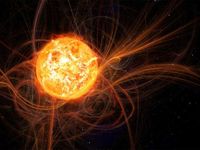March is proving to be a tumultuous month for those sensitive to weather phenomena, as a series of magnetic storms are projected to sweep across various regions of Russia. According to reports from multiple sources, these geomagnetic events could affect not only atmospheric conditions but also the health of many individuals who have a well-documented sensitivity to such disturbances.
The meteorological forecasts reveal that starting March 26, 2025, geomagnetic activity will reach a peak of five points on the K-index scale, indicating the onset of a weak magnetic storm. This level of activity is expected to sustain itself through to March 28, after which geomagnetic readings are predicted to drop back to four points and lower.
Residents of the Samara region are particularly urged to brace themselves for these upcoming storms. On these dates, doctors have advised individuals who are particularly affected by such weather shifts to take precautions: increasing water intake, limiting both alcohol and salt consumption, and managing stress levels.
A similar situation is anticipated in the Voronezh region. Experts from the Laboratory of Solar Astronomy have confirmed that heightened geomagnetic activity will commence on March 27 and will last for approximately 24 hours, also rating this storm at level G1. This forecast suggests that residents might experience fluctuations in their well-being, prompting health professionals to reiterate the importance of self-care during these times.
The effects of geomagnetic activity are not merely anecdotal; it has been scientifically noted that about one-third of the global population experiences adverse effects correlating with magnetic storms. This condition is most pronounced among older adults and individuals with pre-existing health issues. Neurologists have noted that patients often report symptoms like headaches, fatigue, and sleep disturbances during heightened magnetic activity.
Interestingly, the anticipation of magnetic storms is not just based on present conditions; it follows a period of fluctuating solar activity. For instance, substantial increases in solar flare activity were recorded leading up to March 22, 2025, when a significant coronal mass ejection occurred. This powerful release of energy from the sun is noted for its capacity to disturb Earth's magnetosphere, contributing to the geomagnetic fluctuations that ensue. On that day alone, the probability of experiencing a magnetic storm in Volgograd reached a staggering 90% as reported by the Laboratory of Solar Astronomy, accompanying a K-index nearing six out of nine.
As we progress into late March, specifically on the March 23 forecast, authorities believe the Earth will touch a relatively stable geomagnetic state before entering another period of heightened activity at the end of the month. This upcoming wave of disturbances, notably commencing on March 27, will again elevate the K-index, potentially creating conditions favorable for auroras observable even at lower latitudes.
This storm system is significant not just for its immediate effects but for a subsequent potential storm expected in the early days of April 2025. Lasting a full ten days, this upcoming storm possesses the potential for serious impacts on GPS systems and other communication networks, particularly on peak days like April 5 and 8-10, a period ripe with predicted strong solar flares.
For those monitoring their health during these geomagnetic events, experts advocate keeping a keen eye on any physiological symptoms. Recommendations include maintaining hydration with a target of 1.5 to 2 liters of water daily, avoiding heavy meals that may induce lethargy or pressure changes, and ensuring adequate rest. It is acknowledged that maintaining a healthy lifestyle can effectively mitigate the effects many feel during these storms.
Pressure readings in Moscow during this active period are expected to reflect higher-than-normal levels, with 763 mm over the weekend leading into March 22, suggesting that atmospheric variables intertwine with geomagnetic disturbances, affecting those susceptible to such changes.
As we approach this flux of both magnetic storms and changes in atmospheric pressure, the importance of public awareness cannot be overstated. Individuals prone to these weather sensitivities are encouraged to stay informed and take proactive measures to safeguard their health as they navigate through this potentially disruptive period.








